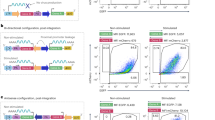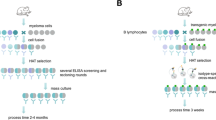Abstract
We have investigated the feasibility of enhancing expression of an immunoglob-ulin-based vector in myeloma cells by coamplification with a mutant dihydrofo-late reductase (mDHFR) gene. Expression of the vector was monitored by the use of tissue plasminogen activator (t-PA) as a reporter gene. During progressive increases of methotrexate concentration in the culture media, the mDHFR gene and the linked t-PA gene amplified approximately 30-fold. A similar increase in mDHFR and t-PA mRNAs was observed. Production of t-PA protein increased in parallel with DNA copy number and RNA, reaching levels 30 to 40-fold higher than those prior to DNA amplification. The capability of amplifying copy number and expression of nonimmunoglobulin genes enhances the utility of this vector-host system for high level production of desired proteins for therapeutic and diagnostic applications.
This is a preview of subscription content, access via your institution
Access options
Subscribe to this journal
Receive 12 print issues and online access
$209.00 per year
only $17.42 per issue
Buy this article
- Purchase on Springer Link
- Instant access to full article PDF
Prices may be subject to local taxes which are calculated during checkout
Similar content being viewed by others
References
Oi, V.T. and Morrison, S.L. 1986. Chimeric antibodies. BioTechniques 4:214–221.
Weidle, U.H. and Buckel, P. 1987. Establishment of stable mouse myeloma cells constitutively secreting human tissue-type plasminogen activator. Gene 57:131–141.
Hendricks, M.B., Banker, M.J., and McLaughlin, M. 1988. A high-efficiency vector for expression of foreign genes in myeloma cells. Gene 64:43–51.
Birch, J.R., Boraston, R., and Wood, L. 1985. Bulk production of monoclonal antibodies in fermenters. Trends in Biotech. 3:162–166.
Duff, R.G. 1985. Microencapsulation technology: a novel method for monoclonal antibody production. Trends in Biotech. 3:167–170.
Simonsen, C.C. and Levinson, A.D. 1983. Isolation and expression of an altered mouse dihydrofolate reductase cDNA. Proc. Natl. Acad. Sci. USA 80:2495–2499.
Haber, D.A. and Schimke, R.T. . 1982. Chromosome-mediated transfer and amplification of an altered mouse dihydrofolate reductase gene. Somatic Cell Genetics 8:499–508.
Dorai, H. and Moore, G.P. 1987. The effect of dihydrofolate reductase-mediated gene amplification on the expression of transfected immunoglobulin genes. J. Immunol. 139:4232–4241.
Kenten, J.H., Wood, C.R., Stephens, P.E., Bendig, M.M., Boss, M.A., and Hentschel, C.C. 1986. A sensitive, nondestructive assay for transfected genes. DNA 5:257–262.
Cheng, S.M., Lee, S.G., Kalyan, N.K., McCloud, S., Levner, M., and Hung, P.P. 1987. Tissue plasminogen activator (tPA) as a reporter gene in transient gene expression. Gene 58:299–303.
Chiang, T.R. and McConlogue, L. 1988. Amplification and expression of heterologous ornithine decarboxylase in Chinese Hamster Cells. Mol. Cell. Biol. 8:764–769.
Kaufman, R.J. and Sharp, P.A. 1982. Amplification and expression ot sequences cotransfected with a modular dihydrofolate reductase complementary DNA gene. J. Mol. Biol. 159:601–621.
Mercola, M., Goverman, J., Mirell, C., and Calame, K. 1985. Immunoglobulin heavy-chain enhancer requires one or more tissue-specific factors. Science 227:266–270.
Potter, H., Weir, L., and Leder, P. 1984. Enhancer-dependent expression of human κ immunoglobulin genes introduced into mouse pre-B lymphocytes by electroporation. Proc. Natl. Acad. Sci. USA 81:7161–7165.
Stafford, J. and Queen, C. 1983. Cell-type specific expression of a transfected immunoglobulin gene. Nature 306:77–79.
Blin, N. and Stafford, D.W. 1976. Isolation of high molecular weight DNA. Nucl. Acids Res. 3:2303–2308.
Maniatis, T., Fritsch, E.F., and Sambrook, J. 1982. Molecular Cloning: A Laboratory Manual. Cold Spring Harbor Laboratory, New York.
Southern, E.M. 1975. Detection of specific sequences among DNA fragments separated by gel electrophoresis. J. Mol. Biol. 98:503–517.
Feinberg, A.P. and Vogelstein, B. 1983. A technique for radiolabeling DNA restriction endonuclease fragments to high specific activity. Anal. Biochem. 132:6–13.
Feinberg, A.P. and Vogelstein, B. 1984. Addendum: a technique for radiolabeling DNA restriction endonuclease fragments to high specific activity. Anal. Biochem. 137:266–267.
Author information
Authors and Affiliations
Rights and permissions
About this article
Cite this article
Hendricks, M., Luchette, C. & Banker, M. Enhanced Expression of an Immunoglobulin-Based Vector in Myeloma Cells Mediated by Coamplification with a Mutant Dihydrofolate Reductase Gene. Nat Biotechnol 7, 1271–1274 (1989). https://doi.org/10.1038/nbt1289-1271
Received:
Accepted:
Issue Date:
DOI: https://doi.org/10.1038/nbt1289-1271



